Insonation of Systemically Delivered Cisplatin-Loaded Microbubbles Significantly Attenuates Nephrotoxicity of Chemotherapy in Experimental Models of Head and Neck Cancer
- PMID: 30189620
- PMCID: PMC6162676
- DOI: 10.3390/cancers10090311
Insonation of Systemically Delivered Cisplatin-Loaded Microbubbles Significantly Attenuates Nephrotoxicity of Chemotherapy in Experimental Models of Head and Neck Cancer
Abstract
The use of cisplatin (CDDP), the most common chemotherapy drug for head and neck cancer, is limited by its undesirable side effects, especially nephrotoxicity. We investigated ultrasound microbubbles (USMB) as a tool to increase the local intra-tumoral CDDP level while decreasing systemic CDDP cytotoxicity. We allowed CDDP to interact with human serum albumin and then sonicated the resulting CDDP‒albumin complex to generate CDDP-loaded MBs (CDDP-MBs). We then established a head-and-neck tumor-bearing mouse model by implanting FaDu-fLuc/GFP cells into severe combined immunodeficiency mice and used IVIS® bioluminescence imaging to determine the tumor xenograft formation and size. Twice weekly (until Day 33), we administered CDDP only, CDDP + MBs + US, CDDP-MBs, or CDDP-MBs + US intravenously by tail-vein injection. The US treatment was administered at the tumor site immediately after injection. The in vivo systemic distribution of CDDP indicated that the kidney was the most vulnerable organ, followed by the liver, and then the inner ear. However, CDDP uptake into the kidney and liver was significantly decreased in both the CDDP-MBs and CDDP-MBs + US groups, suggesting that MB binding significantly reduced the systemic toxicity of CDDP. The CDDP-MBs + US treatment reduced the tumor size as effectively as conventional CDDP-only chemotherapy. Therefore, the combination of CDDP-MBs with ultrasound is effective and significantly attenuates CDDP-associated nephrotoxicity, indicating a promising clinical potential for this approach.
Keywords: chemotherapy; cisplatin; head and neck cancer; microbubble; nephrotoxicity; ultrasound.
Conflict of interest statement
The authors declare no conflict of interest.
Figures








Similar articles
-
Synergistic effects of combined treatment with ultrasound-mediated cisplatin-loaded microbubbles and atorvastatin on head and neck cancer.Head Neck. 2021 Jan;43(1):15-26. doi: 10.1002/hed.26445. Epub 2020 Sep 21. Head Neck. 2021. PMID: 32954561
-
Brain Delivery of Cisplatin Using Microbubbles in Combination with Ultrasound as an Effective Therapy for Glioblastoma.Pharmaceuticals (Basel). 2023 Nov 13;16(11):1599. doi: 10.3390/ph16111599. Pharmaceuticals (Basel). 2023. PMID: 38004464 Free PMC article.
-
Estimating the delivery efficiency of drug-loaded microbubbles in cancer cells with ultrasound and bioluminescence imaging.Ultrasound Med Biol. 2012 Nov;38(11):1938-48. doi: 10.1016/j.ultrasmedbio.2012.07.013. Epub 2012 Aug 25. Ultrasound Med Biol. 2012. PMID: 22929655
-
[Head and neck cancer].Gan To Kagaku Ryoho. 1996 Aug;23(9):1136-42. Gan To Kagaku Ryoho. 1996. PMID: 8751800 Review. Japanese.
-
[New treatments for urogenital toxicity of anti-neoplastic chemotherapy].Gan To Kagaku Ryoho. 1990 Apr;17(4 Pt 2):950-6. Gan To Kagaku Ryoho. 1990. PMID: 2111664 Review. Japanese.
Cited by
-
Tumour targeted contrast enhanced ultrasound imaging dual-modal microbubbles for diagnosis and treatment of triple negative breast cancer.RSC Adv. 2019 Feb 15;9(10):5682-5691. doi: 10.1039/c8ra09737b. eCollection 2019 Feb 11. RSC Adv. 2019. PMID: 35515929 Free PMC article.
-
Ultrasound-induced microbubble cavitation via a transcanal or transcranial approach facilitates inner ear drug delivery.JCI Insight. 2020 Feb 13;5(3):e132880. doi: 10.1172/jci.insight.132880. JCI Insight. 2020. PMID: 31895697 Free PMC article.
-
Combined use of microbubbles of various sizes and single-transducer dual-frequency ultrasound for safe and efficient inner ear drug delivery.Bioeng Transl Med. 2022 Nov 16;8(5):e10450. doi: 10.1002/btm2.10450. eCollection 2023 Sep. Bioeng Transl Med. 2022. PMID: 37693043 Free PMC article.
-
Efficient mRNA Delivery with Lyophilized Human Serum Albumin-Based Nanobubbles.Nanomaterials (Basel). 2023 Apr 5;13(7):1283. doi: 10.3390/nano13071283. Nanomaterials (Basel). 2023. PMID: 37049376 Free PMC article.
-
Genetic variability and mutation of Epstein‒Barr virus (EBV)-encoded LMP-1 and BHRF-1 genes in EBV-infected patients: identification of precise targets for development of personalized EBV vaccines.Virus Genes. 2023 Aug;59(4):541-553. doi: 10.1007/s11262-023-02006-x. Epub 2023 May 27. Virus Genes. 2023. PMID: 37243920 Free PMC article.
References
-
- Sasaki N., Ishi K., Kudo N., Nakayama S.M.M., Nakamura K., Morishita K., Ohta H., Ishizuka M., Takiguchi M. Spatial and temporal profile of cisplatin delivery by ultrasound-assisted intravesical chemotherapy in a bladder cancer model. PLoS ONE. 2017;12:e0188093. doi: 10.1371/journal.pone.0188093. - DOI - PMC - PubMed
Grants and funding
- MOST104-2314-B-016-032-MY3/Ministry of Science and Technology, Taiwan
- TSGH-C107-009/Tri-Service General Hospital
- MAB-107-001/Medical Affairs Bureau Ministry of National Defense
- MOST106-2221-E-011-043-MY3/Ministry of Science and Technology, Taiwan
- NTUST-TSGH-107-02/National Taiwan University of Science and Technology
- MOST103-2314-B-016-003/Ministry of Science and Technology, Taiwan
- TSGH-C104-043/Tri-Service General Hospital
- MAB107-002/Medical Affairs Bureau Ministry of National Defense
- A1071025/Teh-Tzer Study Group for Human Medical Research Foundation
- A1041001/Teh-Tzer Study Group for HumanMedical Research Foundation
LinkOut - more resources
Full Text Sources
Other Literature Sources
Miscellaneous

